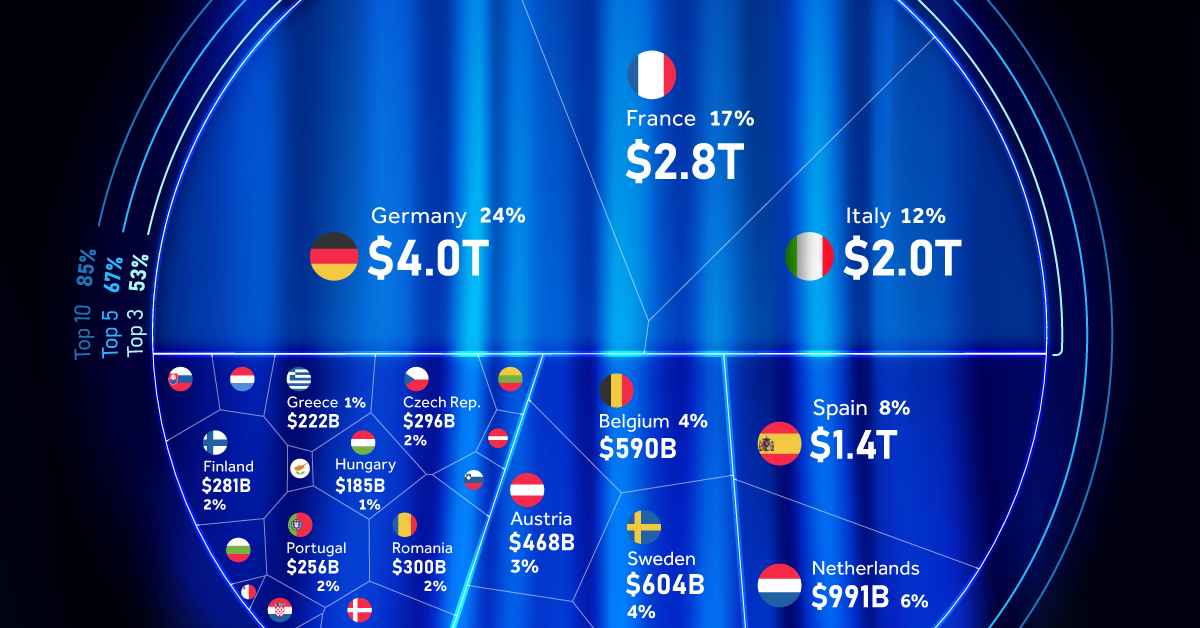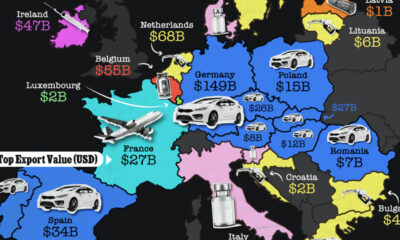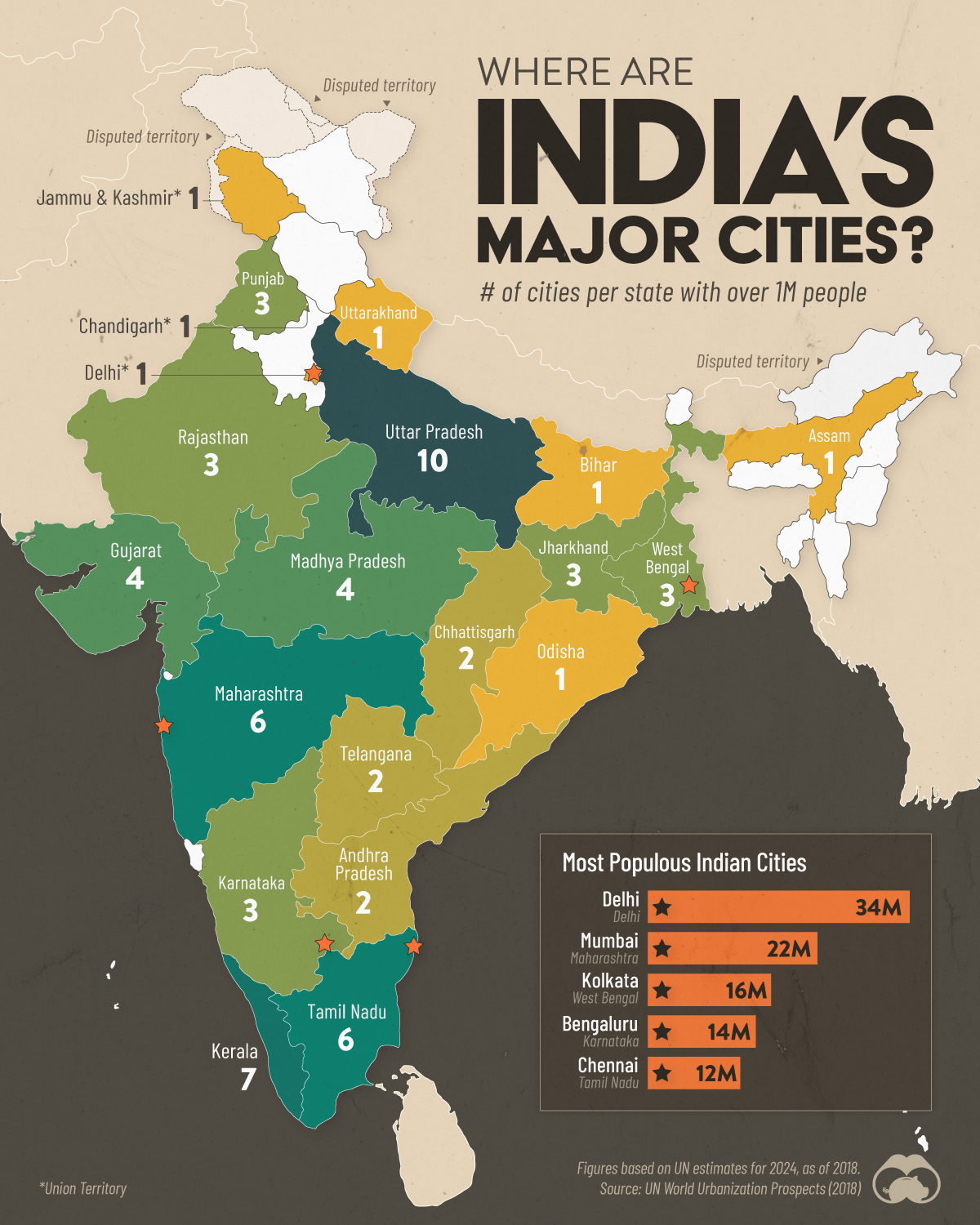Economy
The $16 Trillion European Union Economy
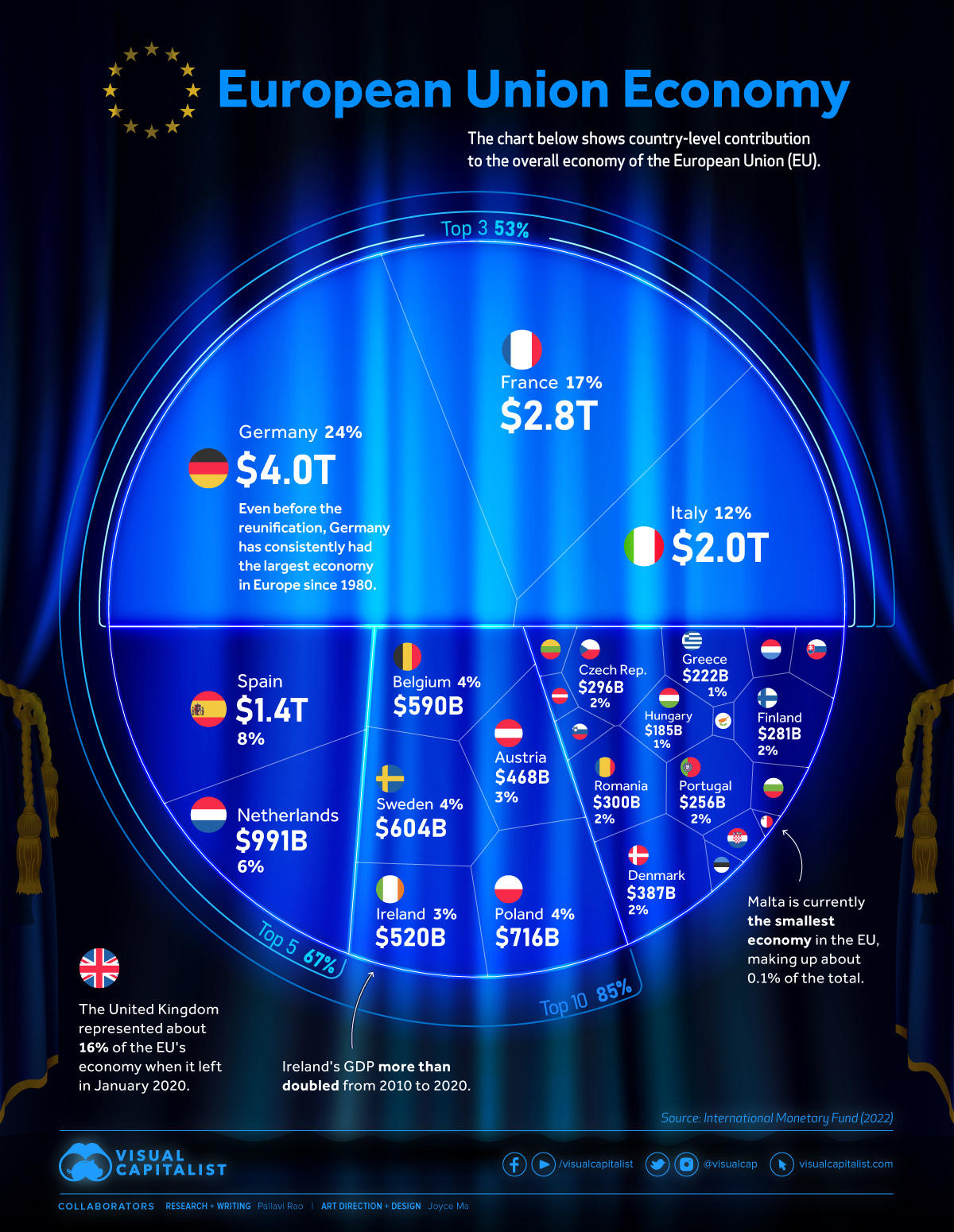
The $16 Trillion European Union Economy
The European Union has the third-largest economy in the world, accounting for one-sixth of global trade. All together, 27 member countries make up one internal market allowing free movement of goods, services, capital and people.
But how did this sui generis (a class by itself) political entity come into being?
A Brief History of the EU
After the devastating aftermath of the World War II, Western Europe saw a concerted move towards regional peace and security by promoting democracy and protecting human rights.
Crucially, the Schuman Declaration was presented in 1950. The coal and steel industries of Western Europe were integrated under common management, preventing countries from turning on each other and creating weapons of war. Six countries signed on — the eventual founders of the EU.
Here’s a list of all 27 members of the EU and the year they joined.
| Country | Year of entry |
|---|---|
| 🇧🇪 Belgium | 1958 |
| 🇫🇷 France | 1958 |
| 🇩🇪 Germany | 1958 |
| 🇮🇹 Italy | 1958 |
| 🇱🇺 Luxembourg | 1958 |
| 🇳🇱 Netherlands | 1958 |
| 🇩🇰 Denmark | 1973 |
| 🇮🇪 Ireland | 1973 |
| 🇬🇷 Greece | 1981 |
| 🇵🇹 Portugal | 1986 |
| 🇪🇸 Spain | 1986 |
| 🇦🇹 Austria | 1995 |
| 🇫🇮 Finland | 1995 |
| 🇸🇪 Sweden | 1995 |
| 🇨🇾 Cyprus | 2004 |
| 🇨🇿 Czechia | 2004 |
| 🇪🇪 Estonia | 2004 |
| 🇭🇺 Hungary | 2004 |
| 🇱🇻 Latvia | 2004 |
| 🇱🇹 Lithuania | 2004 |
| 🇲🇹 Malta | 2004 |
| 🇵🇱 Poland | 2004 |
| 🇸🇰 Slovakia | 2004 |
| 🇸🇮 Slovenia | 2004 |
| 🇧🇬 Bulgaria | 2007 |
| 🇷🇴 Romania | 2007 |
| 🇭🇷 Croatia | 2013 |
Greater economic and security cooperation followed over the next four decades, along with the addition of new members. These tighter relationships disincentivized conflict, and Western Europe—after centuries of constant war—has seen unprecedented peace for the last 80 years.
The modern version of the EU can trace its origin to 1993, with the adoption of the name, ‘the European Union,’ the birth of a single market, and the promise to use a single currency—the euro.
Since then the EU has become an economic and political force to reckon with. Its combined gross domestic product (GDP) stood at $16.6 trillion in 2022, after the U.S. ($26 trillion) and China ($19 trillion.)
Front Loading the EU Economy
For the impressive numbers it shows however, the European Union’s economic might is held up by three economic giants, per data from the International Monetary Fund. Put together, the GDPs of Germany ($4 trillion), France ($2.7 trillion) and Italy ($1.9 trillion) make up more than half of the EU’s entire economic output.
These three countries are also the most populous in the EU, and together with Spain and Poland, account for 66% of the total population of the EU.
Here’s a table of all 27 member states and the percentage they contribute to the EU’s gross domestic product.
| Rank | Country | GDP (Billion USD) | % of the EU Economy |
|---|---|---|---|
| 1. | 🇩🇪 Germany | 4,031.1 | 24.26% |
| 2. | 🇫🇷 France | 2,778.1 | 16.72% |
| 3. | 🇮🇹 Italy | 1,997.0 | 12.02% |
| 4. | 🇪🇸 Spain | 1,390.0 | 8.37% |
| 5. | 🇳🇱 Netherlands | 990.6 | 5.96% |
| 6. | 🇵🇱 Poland | 716.3 | 4.31% |
| 7. | 🇸🇪 Sweden | 603.9 | 3.64% |
| 8. | 🇧🇪 Belgium | 589.5 | 3.55% |
| 9. | 🇮🇪 Ireland | 519.8 | 3.13% |
| 10. | 🇦🇹 Austria | 468.0 | 2.82% |
| 11. | 🇩🇰 Denmark | 386.7 | 2.33% |
| 12. | 🇷🇴 Romania | 299.9 | 1.81% |
| 13. | 🇨🇿 Czechia | 295.6 | 1.78% |
| 14. | 🇫🇮 Finland | 281.4 | 1.69% |
| 15. | 🇵🇹 Portugal | 255.9 | 1.54% |
| 16. | 🇬🇷 Greece | 222.0 | 1.34% |
| 17. | 🇭🇺 Hungary | 184.7 | 1.11% |
| 18. | 🇸🇰 Slovakia | 112.4 | 0.68% |
| 19. | 🇧🇬 Bulgaria | 85.0 | 0.51% |
| 20. | 🇱🇺 Luxembourg | 82.2 | 0.49% |
| 21. | 🇭🇷 Croatia | 69.4 | 0.42% |
| 22. | 🇱🇹 Lithuania | 68.0 | 0.41% |
| 23. | 🇸🇮 Slovenia | 62.2 | 0.37% |
| 24. | 🇱🇻 Latvia | 40.6 | 0.24% |
| 25. | 🇪🇪 Estonia | 39.1 | 0.24% |
| 26. | 🇨🇾 Cyprus | 26.7 | 0.16% |
| 27. | 🇲🇹 Malta | 17.2 | 0.10% |
| Total | 16,613.1 | 100% |
The top-heaviness continues. By adding Spain ($1.3 trillion) and the Netherlands ($990 billion), the top five make up nearly 70% of the EU’s GDP. That goes up to 85% when the top 10 countries are included.
That means less than half of the 27 member states make up $14 trillion of the $16 trillion EU economy.
Older Members, Larger Share
Aside from the most populous members having bigger economies, another pattern emerges, with the time the country has spent in the EU.
Five of the six founders of the EU—Germany, France, Italy, the Netherlands, Belgium—are in the top 10 biggest economies of the EU. Ireland and Denmark, the next entrants into the union (1973) are ranked 9th and 11th respectively. The bottom 10 countries all joined the EU post-2004.
The UK—which joined the bloc in 1973 and formally left in 2020—would have been the second-largest economy in the region at $3.4 trillion.
Sectoral Analysis of the EU
The EU has four primary sectors of economic output: services, industry, construction, and agriculture (including fishing and forestry.) Below is an analysis of some of these sectors and the countries which contribute the most to it. All figures are from Eurostat.
Services and Tourism
The EU economy relies heavily on the services sector, accounting for more than 70% of the value added to the economy in 2020. It also is the sector with the highest share of employment in the EU, at 73%.
In Luxembourg, which has a large financial services sector, 87% of the country’s gross domestic product came from the services sector.
Tourism economies like Malta and Cyprus also had an above 80% share of services in their GDP.
Industry
Meanwhile 20% of the EU’s gross domestic product came from industry, with Ireland’s economy having the most share (40%) in its GDP. Czechia, Slovenia and Poland also had a significant share of industry output.
Mining coal and lignite in the EU saw a brief rebound in output in 2021, though levels continued to be subdued.
| Rank | Sector | % of the EU Economy |
|---|---|---|
| 1. | Services | 72.4% |
| 2. | Industry | 20.1% |
| 3. | Construction | 5.6% |
| 4. | Agriculture, forestry and fishing | 1.8% |
Agriculture
Less than 2% of the EU’s economy relies on agriculture, forestry and fishing. Romania, Latvia, and Greece feature as contributors to this sector, however the share in total output in each country is less than 5%. Bulgaria has the highest employment (16%) in this sector compared to other EU members.
Energy
The EU imports nearly 60% of its energy requirements. Until the end of 2021, Russia was the biggest exporter of petroleum and natural gas to the region. After the war in Ukraine that share has steadily decreased from nearly 25% to 15% for petroleum liquids and from nearly 40% to 15% for natural gas, per Eurostat.
Headwinds, High Seas
The IMF has a gloomy outlook for Europe heading into 2023. War in Ukraine, spiraling energy costs, high inflation, and stagnant wage growth means that EU leaders are facing “severe trade-offs and tough policy decisions.”
Reforms—to relieve supply constraints in the labor and energy markets—are key to increasing growth and relieving price pressures, according to the international body. The IMF projects that the EU will grow 0.7% in 2023.
Maps
Mapped: Indian States with Cities Over 1 Million People
Ten Indian states—most of them from the northeast region of the country—don’t have a single city with 1 million residents.
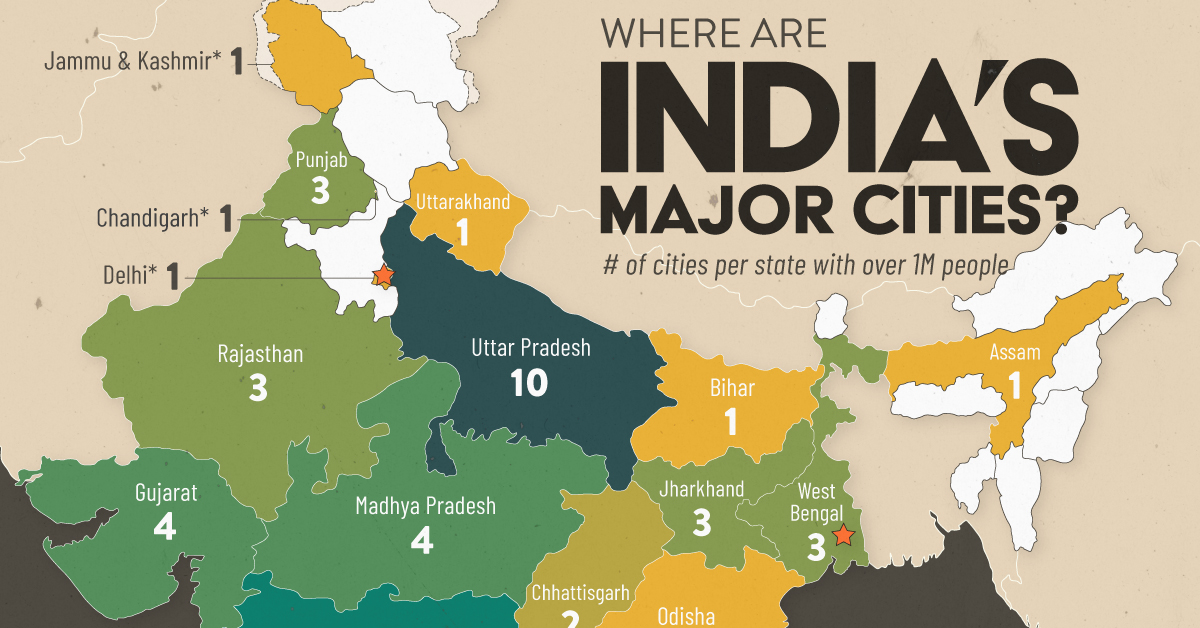
Mapped: Indian States with Cities Over 1 Million People
This was originally posted on our Voronoi app. Download the app for free on iOS or Android and discover incredible data-driven charts from a variety of trusted sources.
Slightly more than one-third of the 1.4 billion Indian population lives in an urban area. So where are the country’s most populous cities, and how are they spread across the country’s 28 states and eight union territories?
This map shows the number of Indian urban agglomerations (cities and districts) with more than a million residents in each jurisdiction. Data for this graphic is sourced from 2024 urban agglomeration estimates in the UN World Urbanization Prospects.
Ranked: Indian States by Cities with 1M Residents
India’s Uttar Pradesh state has 10 cities with a population size of 1 million or more. It is also India’s most populous state, home to 240 million people. This makes it comparable to the size of Pakistan, the fifth most populous country in the world.
| Indian State | Cities with 1M Residents (2024) | City Names |
|---|---|---|
| Uttar Pradesh | 10 | Lucknow, Kanpur, Agra, Meerut, Varanasi, Prayagraj, Bareilly, Aligarh, Moradabad, Saharanpur |
| Kerala | 7 | Kozhikode, Malappuram, Thrissur, Kochi, Thiruvananthapura, Kannur, Kollam |
| Maharashtra | 6 | Mumbai, Pune, Nagpur, Nashik, Aurangabad, Solapur |
| Tamil Nadu | 6 | Chennai, Coimbatore, Madurai, Tiruppur, Tiruchirappalli, Salem |
| Gujarat | 4 | Ahmedabad, Surat, Vadodara, Rajkot |
| Madhya Pradesh | 4 | Indore, Bhopal, Jabalpur, Gwalior |
| Jharkhand | 3 | Jamshedpur, Ranchi, Dhanbad |
| Karnataka | 3 | Bengaluru, Mysore, Hubli-Dharwad |
| Punjab | 3 | Ludhiana, Amritsar, Jalandhar |
| Rajasthan | 3 | Jaipur, Jodhpur, Kota |
| West Bengal | 3 | Kolkata, Asansol, Siliguri |
| Andhra Pradesh | 2 | Visakhapatnam, Vijayawada |
| Chhattisgarh | 2 | Raipur, Durg-Bhilainagar |
| Telangana | 2 | Hyderabad, Warangal |
| Assam | 1 | Guwahati |
| Bihar | 1 | Patna |
| Odisha | 1 | Bhubaneswar |
| Uttarakhand | 1 | Dehradun |
| Chandigarh* | 1 | Chandigargh |
| Delhi* | 1 | New Delhi |
| Jammu & Kashmir* | 1 | Srinagar |
*Union Territories. Figures rounded. Some city names may have changed since this data was published.
Further south, Kerala (7), Maharashtra (6), and Tamil Nadu (6) also have more than five cities with a million or more people.
Meanwhile, some cities, including India’s national capital, New Delhi, are either in or are themselves union territories—areas directly administered by the central government.
Ten Indian states—most of them from the country’s northeast region—don’t have a single city with 1 million residents.
All together, India has 65 cities with more than one million inhabitants. For comparison, China has 105, and the U.S. has nine.
| Rank | City | State/Union Territory | 2024 Population Estimates |
|---|---|---|---|
| 1 | New Delhi | Delhi* | 34M |
| 2 | Mumbai | Maharashtra | 22M |
| 3 | Kolkata | West Bengal | 16M |
| 4 | Bengaluru | Karnataka | 14M |
| 5 | Chennai | Tamil Nadu | 12M |
| 6 | Hyderabad | Telangana | 11M |
| 7 | Ahmadabad | Gujarat | 9M |
| 8 | Surat | Gujarat | 8M |
| 9 | Pune | Maharashtra | 7M |
| 10 | Jaipur | Rajasthan | 4M |
| 11 | Kozhikode | Kerala | 4M |
| 12 | Malappuram | Kerala | 4M |
| 13 | Lucknow | Uttar Pradesh | 4M |
| 14 | Thrissur | Kerala | 4M |
| 15 | Kochi | Kerala | 4M |
| 16 | Indore | Madhya Pradesh | 3M |
| 17 | Kanpur | Uttar Pradesh | 3M |
| 18 | Nagpur | Maharashtra | 3M |
| 19 | Coimbatore | Tamil Nadu | 3M |
| 20 | Thiruvananthapuram | Kerala | 3M |
| 21 | Patna | Bihar | 3M |
| 22 | Bhopal | Madhya Pradesh | 3M |
| 23 | Agra | Uttar Pradesh | 3M |
| 24 | Kannur | Kerala | 2M |
| 25 | Visakhapatnam | Andhra Pradesh | 2M |
| 26 | Vadodara | Gujarat | 2M |
| 27 | Nashik | Maharashtra | 2M |
| 28 | Vijayawada | Andhra Pradesh | 2M |
| 29 | Kollam | Kerala | 2M |
| 30 | Rajkot | Gujarat | 2M |
| 31 | Ludhiana | Punjab | 2M |
| 32 | Madurai | Tamil Nadu | 2M |
| 33 | Raipur | Chhattisgarh | 2M |
| 34 | Meerut | Uttar Pradesh | 2M |
| 35 | Varanasi | Uttar Pradesh | 2M |
| 36 | Srinagar | Jammu & Kashmir* | 2M |
| 37 | Tiruppur | Tamil Nadu | 2M |
| 38 | Jamshedpur | Jharkhand | 2M |
| 39 | Aurangabad | Maharashtra | 2M |
| 40 | Jodhpur | Rajasthan | 2M |
| 41 | Ranchi | Jharkhand | 2M |
| 42 | Kota | Rajasthan | 2M |
| 43 | Jabalpur | Madhya Pradesh | 2M |
| 44 | Asansol | West Bengal | 2M |
| 45 | Gwalior | Madhya Pradesh | 2M |
| 46 | Allahabad | Uttar Pradesh | 2M |
| 47 | Amritsar | Punjab | 1M |
| 48 | Dhanbad | Jharkhand | 1M |
| 49 | Bareilly | Uttar Pradesh | 1M |
| 50 | Aligarh | Uttar Pradesh | 1M |
| 51 | Moradabad | Uttar Pradesh | 1M |
| 52 | Mysore | Karnataka | 1M |
| 53 | Durg-Bhilainagar | Chhattisgarh | 1M |
| 54 | Bhubaneswar | Odisha | 1M |
| 55 | Tiruchirappalli | Tamil Nadu | 1M |
| 56 | Chandigarh | Chandigarh* | 1M |
| 57 | Saharanpur | Uttar Pradesh | 1M |
| 58 | Hubli-Dharwad | Karnataka | 1M |
| 59 | Guwahati | Assam | 1M |
| 60 | Salem | Tamil Nadu | 1M |
| 61 | Siliguri | West Bengal | 1M |
| 62 | Jalandhar | Punjab | 1M |
| 63 | Solapur | Maharashtra | 1M |
| 64 | Warangal | Telangana | 1M |
| 65 | Dehradun | Uttarakhand | 1M |
*Union Territories. Figures rounded. Some city names may have changed since this data was published.
Interestingly, three of the five most populous Indian cities (Mumbai, Kolkata, and Chennai) were villages that became key British trading outposts. As a result all three cities have a fort within their city limits which acted as protection against competing colonial interests at the time.
Finally, Uttar Pradesh—which leads the states by number of cities with 1M people—doesn’t have a single metropolis within the top 10.
-
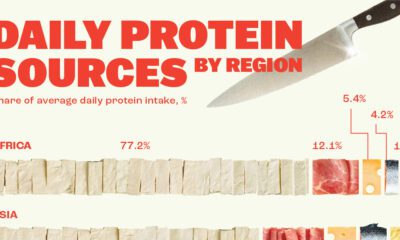
 Healthcare1 week ago
Healthcare1 week agoVisualizing Daily Protein Sources by Region
-

 Globalization2 weeks ago
Globalization2 weeks agoMapped: The Top Exports in Asian Countries
-
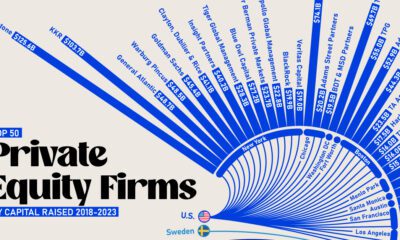
 Finance2 weeks ago
Finance2 weeks agoRanked: The World’s 50 Largest Private Equity Firms
-

 United States2 weeks ago
United States2 weeks agoMapped: The 10 U.S. States With the Lowest Real GDP Growth
-

 United States2 weeks ago
United States2 weeks agoComparing New and Current U.S. Tariffs on Chinese Imports
-

 China2 weeks ago
China2 weeks agoWhich Countries Have the Most Economic Influence in Southeast Asia?
-

 Demographics2 weeks ago
Demographics2 weeks agoThe Top 25 Nationalities of U.S. Immigrants
-

 Countries2 weeks ago
Countries2 weeks agoRanked: Countries Where Youth are the Most Unhappy, Relative to Older Generations




